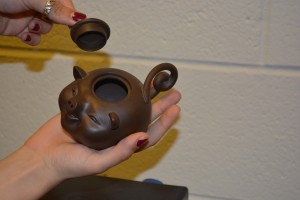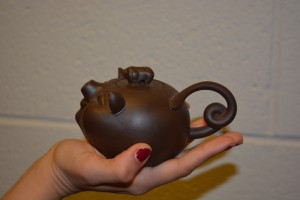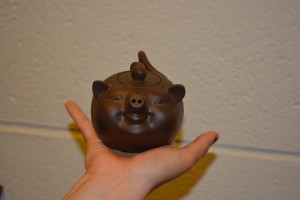Section VII: Found Object – The Pig Teapot
While visiting the local Farmer’s Market, we happened upon a found object of our own. This object took the form of a teapot in the form of a smiling pig, whose snout acted as the spout and whose head acted as the opening through which one would insert tea leaves and hot water. Interestingly, the removable cap used to cover this opening had a piglet with its eyes closed as its handle, and the pot’s handle was made of the pig’s curly tail. Finding the object disturbing, we decided to purchase it and bring it home.
Ultimately, we used the teapot for its intended purpose of making tea, which inspired a number of realizations. First, the piglet-handle and its placement atop the teapot suggested that the associations we hold during childhood remain a part of us, at the top of our minds, even as adults. This interpretation was supported by the piglet’s being blind, as these associations are unaffected by outside influences, just as the piglet would be unaffected by the visual information that surrounds it. Interestingly, we noted that for proper functioning of the teapot, the piglet-cap would have to be held down, demonstrating to us the repression of childhood associations motivated by our desires to perform the traditional functions expected of us in society. At the same time, the piglet-cap is required for proper brewing of the tea (to prevent the contents of the teapot from cooling too quickly before steeping is complete). This suggested that the unconscious associations available to us in childhood are still required for reconfiguration of outside information, just as the Surrealists attempted to unleash their unconscious associations to re-contextualize and recombine the aspects of their society. At the same time, this led us to believe that the unconscious associations are required for creative activity, even though they may not be playing a conscious part in the process, as the piglet-cap is required for the creation of properly brewed tea. Such unconscious activity in the processing of information is not unheard of; the ability of split-brain patients to recreate images that they are not consciously aware of demonstrates the brain’s capacity to store, process, and mediate behavioral effects of information without it ever becoming conscious.

the piglet-cap was found to be detachable

the curly pigtail, by poetic virtue of its alternative title, assumed the associations of the woman
Furthermore, the Muslim background of one of our members provided an additional association tied to the pig. For Muslims, pigs are considered unclean animals whose contents are restricted, mirroring the restrictive associations imposed by societal norms. For this member, the teapot inspired a related sense of repulsion and prohibition. Additionally, the curly pigtail, by poetic virtue of its alternative title, assumed the associations of the woman. However, the piglet-cap was found to be detachable. Combined, these elements revealed to the member that the religious attitudes towards these substituted concepts (pork and women) were similar, in that both had limitations set on how they can be interacted with, as interpreted from their physical connection in the body of the teapot. However, these limitations are not intrinsic to the concepts, as they are separate from the set of uninfluenced, pure childhood associations represented by the piglet-cap. Rather, the limitations were determined to be the result of religious norms imposed on the member’s psyche and conceptions of both pork and women.

